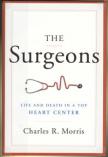Getting to the Heart of It
Charles Morris has written several acclaimed books—on the Gilded Age, financial crises, the A.A.R.P., I.B.M., the arms race, New York City and the Catholic Church in America. He writes like the best professor you ever had—no dumbing down, presenting complex material in an engaging manner with just the right story at just the right time. If the term “public intellectual” did not exist, it would have to be invented for Morris.
Morris’s latest work, The Surgeons, takes on all the key issues—the increasing costs of medical care, the differences between American medical care and that of other Western nations, suggestions for improving American medical care, the roles of the pharmaceutical industry and the F.D.A., the conflicts over the best way to test and measure drugs and medicines and hospitals. But The Surgeons deals with these between-a-rock-and-a-hard-place policy issues only after we have met real doctors and their equally real patients.
The focus of the book is the damaged human heart and what heart surgeons do and think while they try to heal it. The setting is the heart and lung surgery division at Columbia-Presbyterian Hospital in New York City, a premier cardiac surgery center and the country’s largest heart transplant center, with nearly 2,000 annual cases—including a 2004 quadruple bypass operation on President Clinton. Morris’s methodology is ethnographic— embedding himself at the hospital’s cardiothoracic ward, listening in on weekly staff “Morbidity and Mortality” sessions, observing about two dozen operations, meeting with a cross-section of patients and going on “harvest runs“ for organs to be transplanted.
The chief of the heart and lung division, Craig Smith, told the author he “could write about what he saw, good and bad.” Morris did find some things to criticize, but he leaves the hospital about a year later a grateful admirer, not only of the doctors’ awesome surgical skills, but of their humanity—their honesty, courage, stamina and astonishing power of sustained concentration. He finds the expected strong egos, but also deep hearts. While their training is long and vigorous—after becoming a doctor, a five-year training program in general surgery and then, at a minimum, a two-year residency at the cardiothoracic division—their artistry and visual-tactile intelligence are what impress Morris greatly. After all this science, he writes, the critical operating room decisions come down to what will work with this patient, this set of coronary arteries, this misshapen mitral valve.
Morris begins by embedding the reader in the operation room with himself. We witness up close—Morris writes that well—the successful work of a great team (surgeon, anesthesiologists, perfusionists, nurses) during a five-hour repair of a certain Mr. Goldfarb’s 70-year-old diseased heart valve. By contrast, soon after this rousing success we meet the ill-fated Erika Maynard, a heartbreakingly beautiful girl of 4 with cardiomyopathy. Her heart muscle cells are slowly dying. This time the team fails. She dies; they grieve. Afterward, the reader accompanies Morris to the Midwest as he learns how her parents deal psychologically and spiritually with the failure of medical science and the dashing of their religious hopes. This prepares the reader for the analysis that follows.
The Surgeons provides a succinct history of heart surgery and heart transplants. Morris notes their increasing safety, even as they are made more available to more and more older and sicker patients. Between 1970 and 1995, there was a 70 percent drop in the rate per 100,000 of death due to heart attack. By the 1980s transplant technology was on the verge of entering mainstream medicine; and there are probably 200,000 Americans walking around today with a functioning organ from someone else’s body (Morris includes information on how to become a donor).
In working on his book, the author discovered that the future holds alternatives to transplants, and that battery-assisted mechanical hearts will soon enter the mainstream. There are also alternatives to heart surgery, with interventionist cardiologists threading catheters, first with tiny balloons, now with stents, to open blocked arteries. Laparoscopic, camera-assisted surgery will soon be joined by robotic surgery. Such escalating medical complexity makes increasing demands on quality control as well as hospital and doctor accountability. Morris believes that patient safety would be better served by replacing the current system of malpractice litigation with a kind of workman’s compensation system based on expert panels.
The policy implications of these mind-boggling medical breakthroughs evoke a different kind of awe. Within 30 years or so, health care spending could consume about 30 percent of America’s G.D.P. Here Morris is a model of non-ideological rational humanness. He recognizes that in the face of rising costs it will not be easy to keep alive and make more available the kind of patient-centered care he found at Columbia-Presbyterian. Morris suggests a national medical policy that, while falling short of a single-payer system that he deems politically unfeasible, more fully involves government—especially by way of a more progressive tax, so that our health care rests more on our shared human dignity and less on our ability to pay.
In unison with earlier public intellectuals now regarded as sages—Galen, Aristotle, Maimonides—Morris reminds us that good medicine can flourish only in a good society.
This article also appeared in print, under the headline “Getting to the Heart of It,” in the April 14, 2008, issue.








